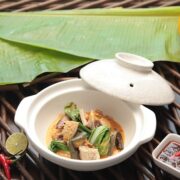The Department of Trade and Industry – Bureau of Philippine Standards (DTI-BPS) has established BPS/TC 92, the technical committee on Filipino Dishes. They will develop the Philippine National Standards (PNS) on popular Filipino dishes such as adobo, sinigang, lechon, and sisig taking into consideration the variations in cooking techniques observed in all regions of the country.
BPS/TC 92 has started developing a PNS for Philippine adobo on 11 May 2021 with “Kulinarya: A Guidebook to Philippine Cuisine” serving as their main reference in creating a comprehensive guide in preparing and cooking the Filipino favorite cuisine – adobo. The standards development process is headed by BPS/TC 92 Chairperson, Chef Glenda Barretto, founder of Via Mare Corporation, and Vice-Chairpersons Chef Myrna Segismundo and Chef Raoul Roberto Goco from Food Writers Association of the Philippines (FWAP) and Hotel and Restaurant Association of the Philippines (HRAP), respectively. They are joined by representatives from the University of the Philippines Diliman – College of Home Economics (UPD-CHE), Philippine Chamber of Food Manufacturers, Inc. (PCFMI), Philippine Association of Meat Processors, Inc. (PAMPI), Department of Science and Technology – Industrial Technology Development Institute (DOST-ITDI), Philippine Association of Food Technologists, Inc. (PAFT), Le Toque Blanche (LTB) Chefs Association, Asia Society Philippines, National Commission for Culture and the Arts, and Philippine Daily Inquirer, Inc.
With various cooking methods for Philippine adobo published online by food writers, bloggers, and vloggers, BPS/TC 92 aims to standardize the cooking technique for the well-known Filipino dish. Chef Myrna Segismundo said, “There will be different approaches and opinions [on cooking Philippine adobo]. As long as I have, say one to three steps, it’s this recipe. Anything else you add to it is a variation to the cooking technique.” The richness of Filipino culture is greatly shown by myriad varieties of Philippine adobo ranging from those with laurel, pepper, soy sauce, vinegar, coconut cream/milk, atsuete, and other ingredients cooked through various methods such as braising and stewing, among others. With this, the question, “How can we say that this is the basic Philippine adobo?” serves as the main guide of BPS/TC 92 members in determining the common denominator among all the known ways of cooking it. Benchmarking the cooking technique for Philippine adobo will help preserve the country’s cultural identity despite the variations made to it. “Adobo is not a recipe. It is a cooking technique,” remarked Chef Raoul Roberto Goco.
BPS Director Neil Catajay underscored that development of standards on Filipino dishes will pave way towards a more distinguished Filipino food culture while establishing the common ground for food businesses. “Standardizing the basic cooking technique for Philippine adobo will help ordinary citizens, foodies, and food businesses determine and maintain the authentic Filipino adobo taste,” added Director Catajay. BPS/TC 92 plans to include other well-loved Filipino dishes such as sinigang, lechon, and sisig to their work program.
The draft PNS on Philippine adobo will be circulated nationwide, once available, for review and comments of concerned stakeholders. For more information on BPS/TC 92, standards, and standardization activities of BPS, please visit the BPS Standards and Conformance Portal at www.bps.dti.gov.ph.





